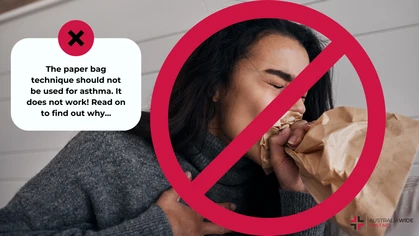Anaphylaxis and Anapen: A Guide to Using Your Auto-Injector for Allergy Emergencies

Allergy and Asthma

Gain the knowledge necessary to administer life-saving treatment and provide effective anaphylaxis first aid in allergy emergencies.
In 2021, the Therapeutic Goods Administration approved a new version of an adrenaline auto-injector, the Anapen. The Anapen treats anaphylaxis through the delivery fixed dose of adrenaline to reduce the severity of a severe allergic reaction, reducing the likelihood of hospitalization and even death in young children. Anapen is an alternative treatment option to the Epipen, with patient preference, ease of use, and previous experience determining whether the Epipen or Anapen is preferred for those who experience severe allergic reactions and anaphylaxis. Although the Anapen and Epipen auto-injectors look similar, they have vastly different administration techniques. For this reason, it is important that you have adequate knowledge of how to administer the new Anapen to prevent incorrectly administering the life-saving treatment. This guide will provide you with a comprehensive overview of the Anapen, anaphylaxis, and how to administer the Anapen as well as anaphylaxis first aid in Allergy Emergencies.What is the Anapen?
The Anapen is a new adrenaline autoinjector used to deliver a dose of epinephrine, also known as adrenaline, to treat anaphylaxis in emergency situations. Typically administered in the outer-thigh region, the Anapen delivers a single fixed dose of adrenaline intramuscularly which can greatly reduce the risk of hospitalisation and even death if administered early enough. The autoinjector can be administered by anyone, including those with no medical training. Adrenaline is used to relieve the immediate symptoms of anaphylaxis. When experiencing an allergic reaction, the body naturally releases adrenaline to open blood vessels and improves blood pressure as well as widen the airways to improve breathing. Injecting adrenalin helps in this natural response. Adrenaline inhaled or ingested is ineffective as it can be broken down by stomach enzymes, hence why it must be injected.
How to Use an Anapen
People who have been diagnosed with a severe allergy and risk of experiencing anaphylaxis should always be carrying an auto-injector with them. If a person is experiencing anaphylaxis, an adrenaline auto-injector, such as the Anapen, should be administered immediately. To administer the Anapen:- Remove the black needle shield by pulling firmly
- Remove the grey safety cap from the firing button so that it clicks
- Hold the open end (the needle end) against the outer-mid thigh - the auto-injector should not be administered into veins, fingers, toes, hands, or feet. It can be administered through clothing but try to avoid pockets or seams.
- Press the firing button so that it clicks. This will indicate that the injection has been administered.
- Hold for 3 seconds
- Slowly remove the adrenaline auto-injector
- Record the time of administration
- Lay the person flat or if they have difficulty breathing, keep them in a sitting position. Do not keep them standing or walking.
- Prevent further exposure to the allergen or trigger substance
- Administer adrenaline via an auto-injector
- For children 10-20khg – 150 microgram intramuscular injection
- For children over 20kg and adults – 300 microgram intramuscular injection
- For children over 50kg and adults – 500 microgram intramuscular injection
- Call an ambulance or seek immediate medical attention
- Administer asthma medication and/or oxygen for breathing difficulty and symptoms
- If the person stops breathing, follow resuscitation and life support procedures.

What is anaphylaxis?
An allergy is an immunological response to a substance that can cause symptoms that range from mild to severe and life threatening. Anaphylaxis is a severe and potentially life-threatening allergic reaction that occurs when the immune system registers the allergen or ‘trigger’ as dangerous. Despite the substance being harmless to most, the person’s immune system will trigger the release of a chemical in the body called Histamine to try and eliminate the “dangerous” trigger. Histamines can cause a number of severe and even life -threatening responses including vasodilation and bronchoconstriction. Vasodilation occurs when the blood vessels widen and allow an increased amount of blood flow. This leads to a sudden drop in blood pressure which can be dangerous. In addition to this, histamines can alter heartbeat rhythm, which affects the amount of blood and rate of blood being pumped to the body. Bronchoconstriction is the narrowing of the airways which makes breathing difficult. This can lead to Pulmonary Edema, a condition where fluid leaks into the lungs and cause further swelling.What are the causes of anaphylaxis?
The most common allergens to trigger anaphylaxis are:- Foods: some of the most common foods to trigger a severe allergic reaction are Peanuts, shellfish, eggs, milk, tree nuts, shellfish, sesame, and soy
- Insect Bites and Stings: common insects that cause anaphylaxis are bees, green ants, wasps, and some species of ticks.
- Medicines: this includes antibiotics, prescription medication such as penicillin, and non-steroidal anti-inflammatory drugs like aspirin. Herbal treatments can also induce an allergic reaction
- General anaesthetics
- Latex: this is a form of rubber found in common household items such as disposable rubber gloves and condoms
- Contrast Agents: substances or dyes used in medical imaging to help areas of the body display better in the scan
- identifying any triggers through allergy testing
- avoiding triggers and allergens where possible
- carrying an adrenaline auto-injector at all times

What are the symptoms of anaphylaxis?
When exposed to an allergen, symptoms can range from mild allergy reactions to anaphylaxis. Mild allergy symptoms include:- Hives or welts on the skin
- Swelling of the face, lips, and/or eyes.
- Tingling and itchy mouth
- Stomach pain and vomiting - this is typically found in those with an insect allergy
- difficult or noisy breathing
- swelling or tightness in the throat
- wheezing or persistent cough
- swollen tongue
- difficulty speaking or a hoarse voice
- pale and floppy (typically in young children)
What are the complications of anaphylaxis?
There are several factors that can increase the severity of an allergic reaction and the risk of experiencing anaphylaxis. This includes:- Amount of exposure to the allergen - typically with food, how much was ingested
- Exercise
- Alcohol Consumption
- Hormonal Changes - this is typically seen within women that are premenstrual or menstrual
- Heat exposure and fatigue
- Presence of anti-inflammatory medication in the system such as aspirin or ibuprofen.
Conclusion
The Anapen is a life-saving device that can be used on anyone experiencing anaphylaxis. Not only is it important to know the signs and symptoms of anaphylaxis but also to understand how to use an Anapen to administer it correctly. With the right preparation and knowledge, you can feel confident in your ability to treat an anaphylactic reaction and prevent making mistakes that could have serious consequences. To learn more about treating anaphylaxis as well as first aid for other medical emergencies, enrol in one of our first aid courses near you:
Originally published at
https://www.australiawidefirstaid.com.au/resources/anaphylaxis-and-anapen-a-guide-to-using-your-auto-injector-for-allergy-emergencies
as part of the Australia Wide First Aid Articles Library









